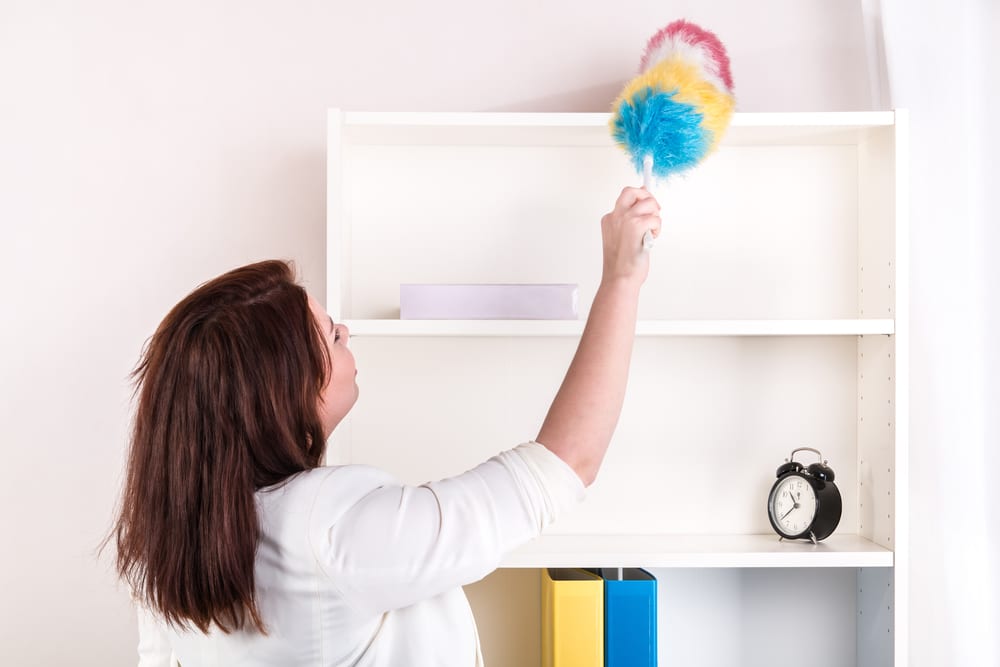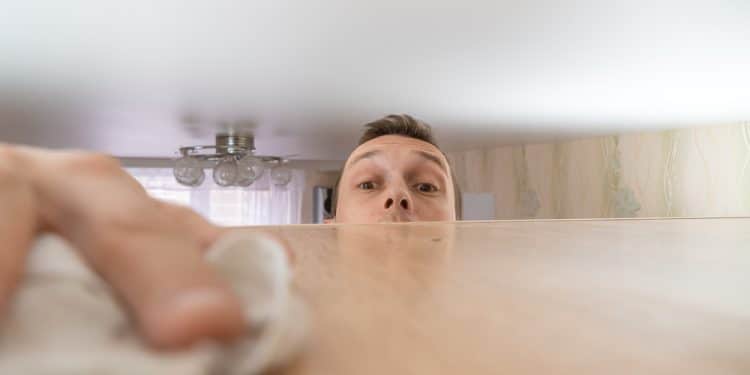You clean your living room, stand back to admire your spotless surfaces… and then—bam—by the next morning, a fine layer of dust has already returned like an uninvited guest. It’s maddening how fast it happens, isn’t it?
The truth is, dust never truly disappears. It’s a sneaky mix of dead skin cells, fibers, outdoor particles, and pet dander that constantly floats through your air and lands right back where you just wiped. But here’s the good news: there are proven ways to prevent dust buildup so it doesn’t come back quite so fast.
Forget endless cleaning sprees — it’s time to clean smarter, not harder. Let’s dive into the genius ways to stop dust from settling in the first place.
Why Does Dust Settle So Fast?
Before you can fight the enemy, you’ve got to understand it. Dust isn’t just “dirt” — it’s a blend of microscopic debris from indoors and outdoors. Around half of the dust in your home actually comes from outside, brought in through open windows, shoes, and clothing. The rest? A mix of fabric fibers, pollen, and even your own skin cells. (Yeah, kind of gross.)
Dust settles faster when your air is dry, your ventilation is weak, or when fabrics release tiny fibers into the air. Carpets, curtains, and soft furniture are like dust factories. Add in static electricity and poor air filtration, and you’ve got yourself a perfect storm.
Understanding these causes helps you better prevent dust buildup instead of constantly reacting to it.
The secret to a cleaner home isn’t cleaning more — it’s setting up small, smart systems that make dust unwelcome. Here’s how to do it, step by step.
1. Upgrade Your Air Filters and HVAC System
Your home’s air system is the front line against dust. If your HVAC or AC filter is old or clogged, it’s just blowing particles right back into your rooms.
Swap your filters every 2–3 months (or sooner if you have pets) and opt for HEPA-grade filters that capture microscopic dust particles. A clean filter keeps air circulating smoothly and dramatically reduces dust settling on furniture.
Pro tip: Write the replacement date directly on the filter frame — future you will thank you.
2. Keep Windows Closed During Windy or Pollen Seasons
Fresh air feels great, but during pollen-heavy or windy days, open windows are dust superhighways. You’re basically inviting outdoor grime to move in rent-free.
If you love fresh air, try ventilating briefly in the early morning or after rain when dust and pollen levels are lowest. For daily airflow, rely on your ventilation system or an air purifier instead.
Little change, big payoff — you’ll quickly see less dust collecting on window sills and tables.
3. Vacuum with a HEPA Filter (and Do It Right)
Regular vacuums can make things worse by spitting fine dust right back into the air. A HEPA-filter vacuum traps particles as small as 0.3 microns — the stuff your eyes can’t even see.
Vacuum slowly to let the machine do its job, and don’t skip soft surfaces like curtains, upholstery, and mattresses. You’ll be shocked how much dust hides there.
Bonus tip: vacuum under beds and sofas once a week — it’s where dust colonies thrive.

4. Ditch Feather Dusters — Use Microfiber Cloths Instead
Feather dusters look fancy, but they just swirl dust around. A microfiber cloth, on the other hand, uses static charge to trap dust inside its fibers instead of spreading it.
Slightly dampen your cloth with water or a mild cleaner before wiping surfaces. This prevents airborne dust clouds and makes cleaning faster.
Keep a few microfiber cloths on hand — one for surfaces, one for electronics, and one for delicate areas. Wash them weekly, and you’ll instantly prevent dust buildup more effectively.
5. Use Fabric Softener Sprays or Anti-Static Solutions
Dust loves static electricity — it’s what makes particles cling to your TV, computer screens, and electronics like magnets.
You can fight static by using anti-static sprays or even a DIY solution:
- Mix 2 cups of water with 2 tablespoons of fabric softener.
- Pour into a spray bottle and lightly mist surfaces (never electronics).
This trick reduces static and helps prevent dust buildup on frequently touched surfaces like shelves, lamps, and picture frames.
6. Change Bedding Weekly and Wash Curtains Often
Beds are dust central — all those fibers, skin cells, and lint add up fast. Wash your bedding once a week in hot water to keep dust mites and allergens in check.
Curtains, pillow covers, and throws should get washed every few weeks too. For an even cleaner setup, consider blinds instead of heavy drapes — they attract less dust overall.
Your bedroom will feel fresher, and your morning sneezes might even disappear.
7. Keep Floors Bare or Use Low-Pile Rugs
Carpets might feel cozy, but they’re also dust traps. The thicker the pile, the more dust it hides.
If you can, go for bare floors like wood, laminate, or tile. Or, choose low-pile rugs that are easy to shake out or wash.
Vacuum rugs at least twice a week, especially in high-traffic areas. You’ll notice the difference in just a few days — floors stay visibly cleaner longer.
8. Control Humidity Levels (40–50% is Ideal)
Dust behaves differently depending on your home’s humidity.
- Too dry, and static electricity attracts more particles.
- Too humid, and dust clumps, sticking to surfaces and corners.
Use a hygrometer to keep your humidity between 40–50%. A small humidifier or dehumidifier can help balance your air and make your dusting efforts last longer.

9. Declutter Surfaces (Less Stuff = Less Dust)
The more surfaces you have, the more dust can land. Simple math.
Keep decor minimal and store smaller items inside boxes or cabinets. Not only does it look cleaner — it stays cleaner.
When you do dust, wipe items as you put them back. You’ll be surprised how much longer your home looks spotless.
10. Add an Air Purifier Where It Matters Most
Air purifiers aren’t just for allergies — they’re your secret weapon against floating dust. Place one in high-traffic rooms like the living room or bedroom.
Look for models with true HEPA filters and low noise output so they can run all day. Some even have smart sensors that adjust automatically when air quality drops.
Cleaner air means fewer dust particles to settle, which means less cleaning for you.
Smart Maintenance Habits to Prevent Dust Buildup
Now that your home is set up for success, the final key is consistency. Even the best systems won’t work without regular upkeep — but it doesn’t have to be overwhelming.
Here are a few smart habits that make a big difference:
- Dust top to bottom: Always start high (shelves, fan blades) and finish low (floors).
- Use a damp mop weekly: It catches leftover particles your vacuum misses.
- Shake rugs and doormats outside: It keeps dust from coming back in.
- Clean vents and ceiling fans monthly: They’re hidden dust spreaders.
- Wipe electronics with anti-static cloths: They attract dust like magnets.
These little routines take just minutes but dramatically prevent dust buildup over time. Once your air is cleaner and your surfaces are less static, you’ll find you can stretch cleaning days further apart — and your home still looks fresh.
The Bottom Line
If there’s one universal truth about home maintenance, it’s this: dust always comes back — but it doesn’t have to win. The secret isn’t about becoming obsessed with cleaning; it’s about creating a space that naturally resists dust before it ever has a chance to settle.
Think about it like this: every time you swap an air filter, wash your bedding, or choose microfiber over a feather duster, you’re changing how your home behaves. You’re setting up small systems that quietly protect your space while you live your life. The beauty of these smart dust prevention habits is that they start compounding. Within a week, your surfaces stay cleaner longer. Within a month, the air feels lighter. Over time, you’ll notice you can breathe easier — literally.
And the payoff goes beyond aesthetics. A dust-free environment means better indoor air quality, which is crucial if you or your family members deal with allergies or asthma. Less dust means fewer irritants in the air, fewer sneezes, and less time spent chasing tumbleweeds across your floors. It also helps your electronics and HVAC systems run more efficiently, saving money in the long run.
There’s also something deeply satisfying about walking into a clean, well-kept space that doesn’t look like you just spent hours scrubbing. The subtle shine on a surface that’s stayed spotless for days? That’s a quiet kind of joy — the reward for making your home work smarter, not harder.
So, as you start applying these genius tips — swapping to HEPA filters, decluttering, balancing humidity, and keeping microfiber cloths on hand — remember this: consistency beats intensity. You don’t need to clean daily; you just need the right habits.
With these simple but powerful tweaks, you can finally prevent dust buildup for good — and reclaim your time, your energy, and your peace of mind.
Because when your home stays clean effortlessly, it’s not just your surfaces that feel lighter — it’s you.


